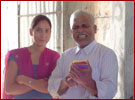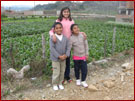
|
|
Situation of children and women in Nepal 2006 THE SCHOOL-AGED CHILD The government's education policy promotes compulsory, free schooling for children aged from five to nine years. However, at present only about four out of every five primaryschool- aged children are enrolled in school . In addition, dropout and repetition rates are high, particularly in Grade 1, with one in three children repeating Grade 1 and 15 per cent dropping out .Even if children complete primary schooling, they have not always mastered the content: the average scores in grade 5 learning achievement tests in 2003 were 33 per cent for Mathematics and 56 per cent for Nepali . Only half of children complete primary school. Of these, three-quarters go on to secondary school . Enrolment for lower secondary school is about 43 per cent, and 30 per cent for higher secondary school . The literacy rate for children of secondary school age is 79 per cent . Girls and dalits are more likely than other groups to be out of school in Nepal. There are numerous reasons for families not sending their children to school. For girls from some families, education is viewed as a 'poor investment' since daughters leave their family home at marriage and the benefit of their 'learning' is given to someone else. Even if girls are sent to school when they are young, as they grow older marriage can prevent them from being able to complete their education. The poverty of some families means that they are unable to meet the costs of educating their children. If a choice has to be made between sending a boy or a girl to school, the boy will usually be given precedence. In addition, some families cannot afford the opportunity costs of lost income or labour to educate their children. Girls are more likely than boys to have to look after the home while other family members go out to work. For Dalits, caste discrimination can make it difficult to attend school. School can also be too far away from home, and there may be a lack of sufficient places for all children living in the surrounding area. For children at school, poor-quality facilities and unsuitable teaching methods often result in an environment that is neither child-friendly nor conducive to learning. It is common for schools to lack classroom space, and be poorly equipped with no seating, no desks, no blackboard, a lack of adequate lighting, and a roof that leaks when it rains. Many schools lack toilets and a clean water supply. Classroom materials are insufficient and poor quality. Nepali as the language of instruction may present problems for children from non- Nepali-speaking communities. Corporal punishment and verbal abuse are commonplace. For children who have never been to or dropped out of primary school, the government has an alternative education programme. The Out-of-School Programme aims to provide children with basic literacy and numeric skills, and can also help children to enter the formal schooling system. It is a two-level programme: completion of OSP I is intended to be the equivalent of a Grade 3 education and completion of OSP II is intended to be the equivalent of Grade 5. Availability of the Out-of-School Programme can vary due to quota limitations and not having enough candidates in a settlement to run a class, and many out-of-school children do not receive this second chance. As children grow older, an increasing proportion either become labourers without entering school or leave school prematurely to find employment. Child labour affects an estimated 2.6 million of the country's 7.9 million children aged 5-14 years . Most of these children, particularly the younger ones, work for their families either in the household or on the farm. However, it is estimated that over 100,000 children work in the worst forms of child labour as domestic workers, porters, bonded labourers, factory workers, rag pickers, and coal miners. As well as child labourers, children particularly vulnerable to lack of protection in Nepal include those without primary caregivers such as orphans, those in conflict with the law, street children, and institutionalized children. In addition, children can be vulnerable to sexual abuse by relatives, peers, teachers and strangers. In Nepal, where sexual taboos are strong, it is very difficult for any children to talk about sexual experiences, particularly if they are being abused, as children's concerns are rarely listened to and impunity is customary. It is also hard for children who experience violence to find support and justice. Disabled children, children with HIV/AIDS, and children without birth registration are also vulnerable to a lack of protection in Nepal. The armed conflict has affected children of all ages through its impact on their families. However, it has particularly affected children by disrupting their education and interfering with their access to healthcare. Some children have been removed from school to help at home, as older members of the family have migrated away from their home village to avoid recruitment by the Communist Party of Nepal- Maoist (Maoist) or harassment by the security forces. Children of families displaced by the fighting can expect their schooling to be temporarily suspended or even stopped, their access to healthcare to be made more difficult, and their living and environmental conditions to deteriorate and become less stable. Some children will be pushed into the labour market. Children who become separated from their families or become orphaned are particularly vulnerable to violations of their rights. In a number of cases, children have been killed or injured as a direct result of the conflict, or detained by either the Maoists or the State's security forces. THE ADOLESCENT CHILD The status of adolescents is a decidedly grey area in Nepal. In some ways they are still treated as a child and in other ways they are expected to be an adult. The legal age of majority in Nepal is 18 years. However, society often views children much younger than this as being able to take on responsibilities more closely associated with adulthood than childhood. This is particularly true for many girls and for children from poor households. The majority of Nepali adolescents are not in school. About a third of children aged 13-16 years are enrolled in secondary school . When adolescent children leave school they usually enter the workforce. Over half of 15- 19 year olds claim to be economically active . Children of this age run a high risk of labour exploitation, especially as they are more likely than younger children to leave their family or home to find work. The escalation of the conflict during the past few years has reinforced this trend, as young people leave their homes for security as well as work. Some of the worst forms of exploitation affect adolescents, for instance, over half of trafficked girls were aged 15-18 years when they left their family . Although this is the age that most people in Nepal first become sexually active, adolescent girls and boys have little access to accurate information on sex. Formal sexual education in school is extremely weak. Four out of five adolescents learn about sexual matters from their friends . These limitations mean that young people can be vulnerable to sexually transmitted diseases such as HIV/AIDS, syphilis and gonorrhoea. Although sexual activity in Nepal has traditionally been associated with marriage, a growing number of teenagers consider premarital sex to be acceptable, with one in five unmarried boys and nearly one in 10 unmarried girls claiming to have had a sexual experience . Although HIV/ AIDS is currently considered to be concentrated in specific high-risk groups in Nepal, young people are regarded as a potential link for HIV/AIDS to spread into the general population. Most Nepalese teenagers are aware of HIV/AIDS and and its main modes of transmission. Sexual intercourse is better known as a potential risk than sharing of needles for injection. Three in four teenagers can identify using a condom during sex as a means of protection; however, this awareness does not always translate into safe sexual behaviour . Adolescence can lead directly into marriage and parenthood for children in Nepal, particularly for those in rural areas, and especially for girls. Once married, they are expected to take on the roles demanded of their gender by society. This usually means that girls become mothers and caregivers, and boys become breadwinners for their family. These rigid gender roles handed down from generation to generation remain very strong in Nepal. The material for this page is from www.un.org.np/reports/UNICEF/2006/situation-analysis/conver-page.pdf
|




